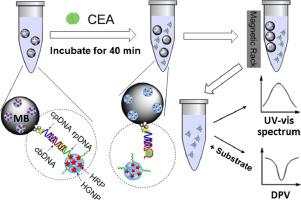Sensors and Actuators Reports ( IF 6.5 ) Pub Date : 2020-09-28 , DOI: 10.1016/j.snr.2020.100021 Qiong-Lin Wang , Hui-Fang Cui , Chun-Ling Li , Xiaojie Song , Qi-Yan Lv , Zong-Yi Li

|
A fast and sensitive carcinoembryonic antigen (CEA) aptasensor with multiple detection modes was developed. It is based on hollow gold nanoparticles (HGNPs) and horse radish peroxidase (HRP) as both labels and signal amplification elements. In fabrication, capture DNA (cpDNA) was modified on magnetic beads, and reporter DNA (rpDNA) and HRP were co-modified on HGNPs. A combination DNA, containing a DNA aptamer (GAC-P) segment, hybridized with cpDNA and rpDNA, forming a satellite-structured biosensor. In response to CEA, the aptamer switches its structure, releasing rpDNA/HGNPs/HRP under magnetic separation. The surface plasmon resonance of HGNPs and the HRP enzyme activity of the supernatant were observed/detected with naked eyes, UV–vis spectroscopy, and electrochemistry techniques. The assay time is as short as ~45 min. CEA levels can be differentiated with naked eyes. The absorbance at 677 nm is linearly proportional to CEA concentration from 10 to 250 ng mL−1, with a limit of detection (LOD) of 8.6 ng mL−1. In contrast, the differential pulse voltammetry (DPV) peak current at -0.057 V is linearly correlated with CEA concentration in the range of 2−250 ng mL−1, with an LOD of 0.78 ng mL−1. The LOD values are lower than cancer patient threshold levels. The aptasensor exhibits negligible responses to interfering proteins. In addition, it displays good reproducibility, stability, accuracy and easiness of usage. The recovery rate for CEA spiked human serum samples are 100±5%. The developed assay strategy should provide a general platform for detecting other interested biomarkers.
中文翻译:

基于空心金纳米粒子和适体结构转换的多模适体传感器:快速,灵敏地检测癌胚抗原
开发了一种具有多种检测模式的快速灵敏的癌胚抗原(CEA)适体传感器。它基于空心金纳米颗粒(HGNP)和辣根过氧化物酶(HRP)作为标记和信号放大元件。在制造中,捕获DNA(cpDNA)在磁珠上进行了修饰,而报告DNA(rpDNA)和HRP在HGNP上进行了共修饰。包含DNA适体(GAC-P)片段的组合DNA与cpDNA和rpDNA杂交,形成卫星结构的生物传感器。响应CEA,适体改变其结构,在磁分离下释放rpDNA / HGNPs / HRP。HGNP的表面等离振子共振和上清液中的HRP酶活性可用肉眼,紫外-可见光谱和电化学技术进行观察/检测。测定时间短至〜45分钟。裸眼可以区分CEA水平。677 nm处的吸光度与10至250 ng mL的CEA浓度成线性比例-1,检测限(LOD)为8.6 ng mL -1。相反,-0.057 V的差分脉冲伏安(DPV)峰值电流与CEA浓度在2-250 ng mL -1范围内线性相关,LOD为0.78 ng mL -1。LOD值低于癌症患者的阈值水平。适体传感器对干扰蛋白的反应微不足道。此外,它还具有良好的可重复性,稳定性,准确性和易用性。CEA加标的人血清样品的回收率为100±5%。制定的检测策略应提供一个检测其他感兴趣的生物标志物的通用平台。











































 京公网安备 11010802027423号
京公网安备 11010802027423号